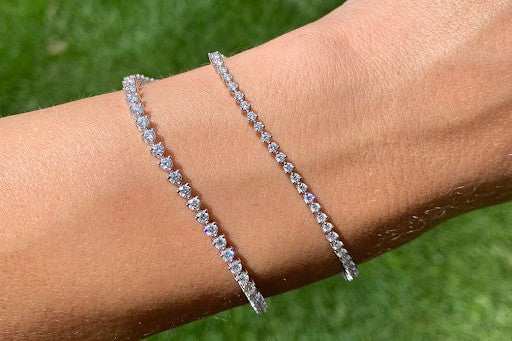Lab diamonds have become increasingly popular in recent years as more people seek ethical, sustainable, and affordable alternatives to mined diamonds. These diamonds, created in controlled laboratory environments, share the same physical, chemical, and optical properties as natural diamonds but without the ethical and environmental issues associated with traditional diamond mining. In this article, we will provide a comprehensive lab diamonds guide to help you understand what lab diamonds are, how they are made, their benefits, and how to choose the right one for your needs.
What Are Lab Diamonds?
Lab diamonds, also known as lab-grown diamonds or synthetic diamonds, are diamonds produced in a laboratory using advanced technological processes that replicate the natural conditions under which diamonds form deep within the Earth. They are chemically, physically, and optically identical to natural diamonds, with the same brilliance, hardness, and durability. The key difference between lab diamonds and mined diamonds is that lab diamonds are created in a controlled environment, avoiding the environmental and ethical concerns that come with traditional diamond mining. In this lab diamonds guide, we will explore how these diamonds are made and why they are becoming increasingly popular.
How Are Lab Diamonds Made?
There are two primary methods used to create lab diamonds: High Pressure High Temperature (HPHT) and Chemical Vapor Deposition (CVD). Both of these processes mimic the conditions that occur deep within the Earth’s mantle, where natural lab diamonds guides are formed.
The HPHT method involves placing carbon in a press under extreme pressure and temperature to recreate the conditions that cause natural diamonds to form. This method has been used for decades to create small diamonds, typically used in industrial applications, but it is now also used to create gem-quality diamonds for jewelry.
The CVD method, on the other hand, involves using a gas mixture that contains carbon, which is then heated to create a plasma. The carbon atoms in the plasma bond together to form diamond crystals. CVD diamonds are typically known for their exceptional clarity and are often used in high-quality jewelry, including engagement rings.
Both methods result in diamonds that are chemically identical to natural diamonds, meaning they are just as brilliant, durable, and stunning. This makes lab diamonds an excellent alternative for those seeking ethical and sustainable options.
The Benefits of Lab Diamonds
One of the primary benefits of lab diamonds, as highlighted in this lab diamonds guide, is their ethical and environmental appeal. Traditional diamond mining can lead to significant environmental damage, including deforestation, soil erosion, and water pollution. Additionally, mining operations in some regions are linked to human rights abuses, such as poor labor conditions and conflict financing.
Lab diamonds, in contrast, are created in controlled environments with much less environmental impact. They do not require large-scale mining or extraction, which helps reduce their carbon footprint. Furthermore, lab diamonds are free from the ethical concerns that can be associated with mined diamonds. For consumers who are concerned about the origins of their diamonds, lab-grown diamonds offer a transparent and responsible alternative.
Another significant benefit of lab diamonds is their affordability. Lab diamonds are generally 20-40% less expensive than natural diamonds of similar size and quality. Because they are produced in a controlled environment, the production costs are lower, allowing consumers to purchase larger or higher-quality diamonds at a more affordable price. In this lab diamonds guide, we will explain how this price difference makes lab diamonds a cost-effective option for engagement rings, wedding bands, and other fine jewelry.
How to Choose the Right Lab Diamond
When selecting a lab diamond, there are several factors to consider to ensure that you choose the best one for your needs. Just like natural diamonds, lab diamonds are graded based on the Four Cs: Cut, Color, Clarity, and Carat weight.
The cut of the diamond refers to how well the diamond has been shaped and faceted, which affects its brilliance. Lab diamonds are available in a variety of cuts, including round, princess, emerald, and oval, so you can choose the shape that best suits your personal style.
Color is another important factor. Lab diamonds are graded on a scale from D (colorless) to Z (light yellow or brown). The best lab diamonds are typically near colorless, offering a clear and brilliant appearance. If you are looking for a diamond with little to no color, choosing a diamond with a higher color grade, such as D, E, or F, will ensure a stunning result.
Clarity refers to the presence of any internal or external flaws, known as inclusions or blemishes. Lab diamonds can have varying degrees of clarity, with diamonds graded as Flawless (FL) or Internally Flawless (IF) being the most desirable. However, even diamonds with slight inclusions can be stunning when cut and polished well, so clarity may depend on your personal preference.
Carat weight is the size of the diamond. Larger diamonds are generally more expensive, but lab diamonds are more affordable than natural diamonds, so you may be able to purchase a larger stone within your budget.
In this lab diamonds guide, it’s essential to emphasize the importance of purchasing a certified diamond. A certified lab diamond has been graded by a reputable gemological organization, such as the Gemological Institute of America (GIA) or the International Gemological Institute (IGI), ensuring that the diamond has been properly evaluated and meets industry standards.
Lab Diamonds vs. Mined Diamonds: What’s the Difference?
As mentioned in this lab diamonds guide, the primary difference between lab grown diamonds and mined diamonds is their origin. While mined diamonds are extracted from the Earth, lab diamonds are created in a laboratory using advanced technology. However, there are no differences in the physical properties of the diamonds. Both lab and mined diamonds are made of pure carbon, and they share the same hardness, brilliance, and durability.
The main advantages of lab diamonds are their ethical sourcing and lower cost. Mined diamonds can contribute to environmental degradation and human rights issues, while lab diamonds are created in a controlled environment, minimizing their impact. Additionally, lab diamonds are typically more affordable than their mined counterparts, allowing consumers to purchase larger or higher-quality diamonds at a lower price.
The Future of Lab Diamonds
The lab diamonds industry continues to grow as more consumers seek ethical, sustainable, and affordable options for their jewelry. Advances in technology are making it possible to create larger, higher-quality diamonds, and the cost of producing lab diamonds is expected to decrease over time, making them even more accessible to a wider range of consumers.
As awareness of the ethical and environmental benefits of lab diamonds continues to spread, they are likely to become an even more popular choice for engagement rings, wedding bands, and other fine jewelry. In this lab diamonds guide, we have explored the many reasons why lab diamonds are the future of the diamond industry.
Conclusion
Lab diamonds offer a stunning, ethical, and affordable alternative to traditional mined diamonds. They are created in controlled environments using advanced technology, ensuring they are chemically, physically, and optically identical to natural diamonds. With their ethical sourcing, lower cost, and high quality, lab diamonds are becoming a popular choice for consumers who want to make a responsible and stylish purchase. Whether you are shopping for an engagement ring or any other fine jewelry, lab diamonds offer a beautiful option that combines luxury with responsibility. By following the tips in this lab diamonds guide, you can make an informed decision when selecting the perfect lab-grown diamond for your needs.




